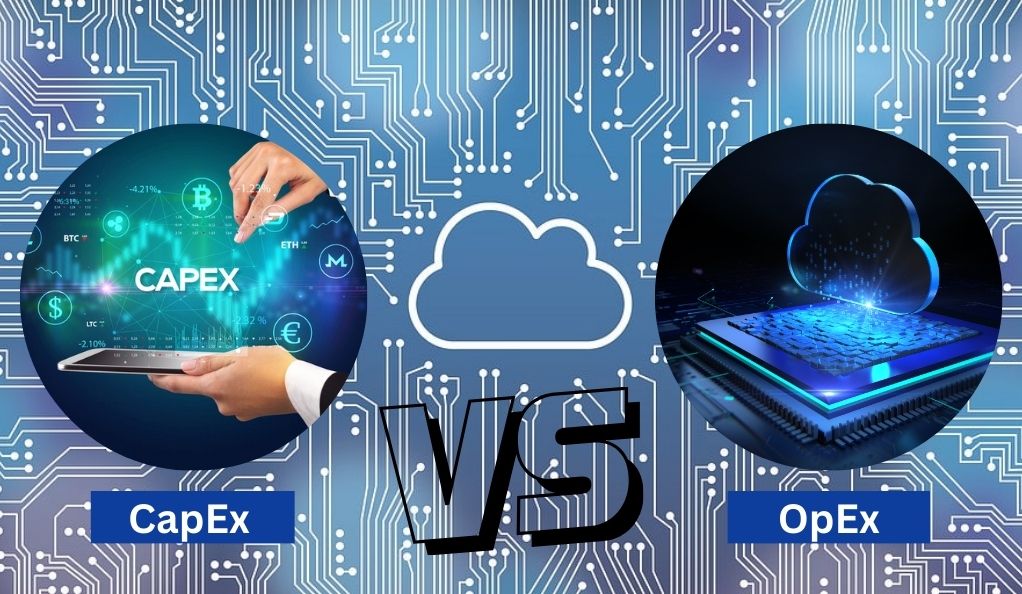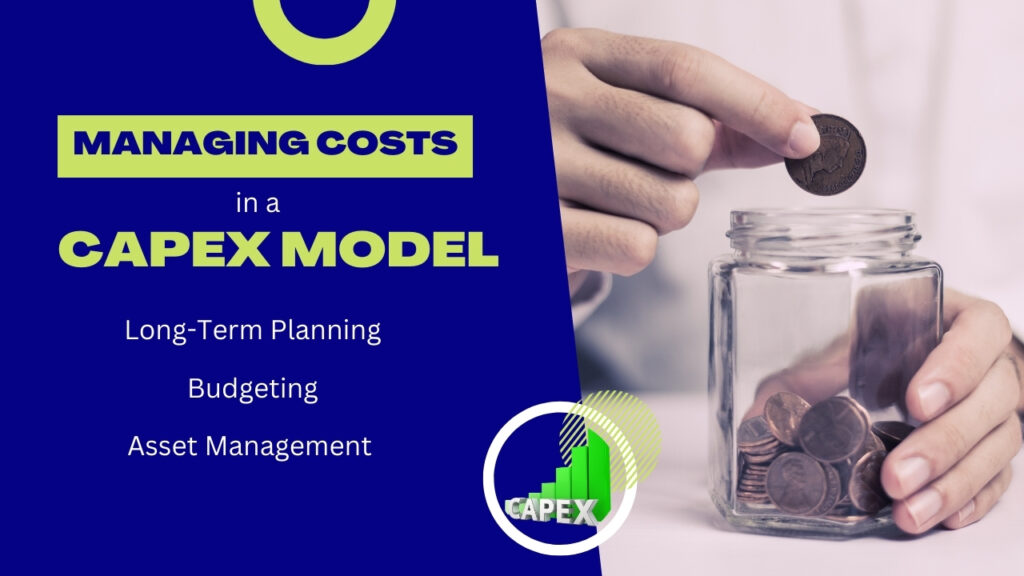
CapEx vs OpEx in Cloud Computing: A Complete Guide
In today’s fast-moving tech world, understanding the costs linked with cloud computing is crucial. Two terms often heard in this area are CapEx and OpEx. They are different ways businesses think about and manage their money, especially when it comes to IT and cloud services.
The Shift in IT Landscape Towards Cloud Computing
The IT world is changing fast, with a big move towards cloud computing. This shift means companies are rethinking how they spend their IT budgets. In the past, a lot of spending was CapEx, like buying servers or setting up data centers. Now, with cloud services, there’s a move towards more OpEx, where companies pay for what they use, as they use it. This change affects how companies plan their finances, manage resources, and grow in the fast-paced digital world.
Definition and Basics of CapEx
CapEx, short for Capital Expenditures, refers to the money a company spends on physical things that last a long time. Think of it like buying a car or building a house. In the IT world, CapEx could be spending on servers, buildings, or big, expensive equipment. This kind of spending usually happens once, and the items bought are used for many years. A key point about CapEx is that these purchases are seen as investments and their cost is spread over their useful life.
Definition and Basics of OpEx
OpEx, or Operating Expenditures, is different. It’s like the day-to-day money a business spends to keep things running smoothly. If CapEx is buying a car, then OpEx is the gas you put in it. In terms of cloud computing, OpEx covers things like monthly cloud service fees or maintenance costs. This type of spending is ongoing and usually covers services or products used up within a year.
The Traditional IT Spending: CapEx Approach

In the traditional IT spending model, businesses often lean towards the CapEx approach. This way of spending has been around for a long time and is all about making big purchases that will be useful over many years.
Understanding Capital Expenditures in Depth
Capital Expenditures, or CapEx, involves spending a large amount of money upfront on physical assets. These are not everyday purchases but significant investments in the company’s future. For example, a company might buy servers, build data centers, or invest in expensive software licenses. These items are expected to last for years, providing long-term value to the business. Here are some key points about CapEx:
- Long-term Investment: CapEx is about spending now for benefits that last many years.
- High Upfront Cost: It involves a large amount of money spent at once.
- Depreciation: These assets lose value over time, and this decrease in value is accounted for in the company’s financials.
- Tax Implications: The cost of CapEx items can often be spread over several years for tax purposes.
Typical Examples of CapEx in Cloud Computing
When it comes to cloud computing, CapEx still plays a role. Even though the cloud is often associated with OpEx, there are CapEx elements too. For instance:
- Physical Infrastructure: This includes things like purchasing servers or building a facility to house these servers.
- One-time Software Purchases: Sometimes, companies might buy a software license outright instead of paying a recurring fee.
- Setting Up In-House Data Centers: For businesses not fully in the cloud, setting up and maintaining their data centers is a significant CapEx.
Accounting and Tax Implications of CapEx
In CapEx, the money spent is treated as an asset on the company’s balance sheet. This asset then depreciates over its useful life. Each year, a portion of its cost is counted as an expense, which can reduce taxable income. It’s a way of acknowledging that the asset is losing value as it gets older and is used up.
Challenges Associated with CapEx Spending
Despite its benefits, CapEx has its challenges:
- High Upfront Costs: Large initial investments can be a strain on a company’s cash flow.
- Risk of Technological Obsolescence: With the rapid pace of tech changes, today’s investment might become outdated quickly.
- Inflexibility: Once you’ve invested in a physical asset, it’s not easy to change course if your business needs shift.
The Modern IT Spending: OpEx Model
In recent years, there’s been a shift towards the OpEx model in IT spending, especially with the rise of cloud computing. This model is more about spending money on ongoing services and operations rather than making big, one-time purchases.
Operational Expenditures Explained
Operational Expenditures, or OpEx, is the money spent on the day-to-day running of a business. In the cloud computing context, this means paying for cloud services and other IT needs as they are used. Unlike CapEx, where you buy and own assets, OpEx is like renting what you need, when you need it. Key features of OpEx include:
- Pay-as-you-go: You only pay for services as you use them.
- No Large Upfront Costs: Unlike CapEx, OpEx doesn’t require a huge initial investment.
- Flexibility: It’s easier to scale up or down based on your current needs.
- Tax Benefits: OpEx costs are often fully deductible in the same year they’re incurred.
Common Examples of OpEx in the Cloud
In the realm of cloud computing, OpEx can take various forms:
- Subscription Services: This includes monthly or yearly subscriptions to software or cloud platforms.
- Cloud Service Fees: Paying for the cloud storage or computing power you use.
- Maintenance and Support Costs: Ongoing expenses to keep everything running smoothly.
The Flexibility and Scalability of OpEx
One of the biggest advantages of OpEx is its flexibility. You can adjust your spending based on current needs without being tied down by previous investments. This adaptability is especially valuable in the fast-paced world of technology, where business needs can change rapidly.
Tax Deduction and Financial Reporting in OpEx
From a financial standpoint, OpEx offers immediate tax benefits. Expenses are fully deductible in the year they’re made, which can be advantageous for tax purposes. On financial statements, OpEx appears as an expense, reflecting the cost of operations during that period.
The OpEx model aligns well with modern business practices, offering flexibility and scalability that are essential in today’s dynamic market environment. It allows companies to stay agile and responsive, making it a popular choice for those looking to leverage cloud computing effectively.
Comparative Analysis: CapEx vs OpEx
When it comes to managing IT spending, understanding the differences between CapEx and OpEx is vital. Both have their own benefits and challenges, and choosing the right one depends on a company’s specific needs and goals. Let’s break down these two models to see how they compare.
Initial Costs: Upfront vs Pay-as-you-go
CapEx: Requires a large sum of money upfront. It’s like buying a car; you pay a big amount to own it.
OpEx: More like renting a car. You pay smaller amounts regularly, only for what you use.
Long-term Value and Depreciation
CapEx: The value of what you buy goes down over time (depreciation). But, you get to use these assets for many years.
OpEx: There’s no concern about things losing value over time since you’re not owning them.
Control and Management of Infrastructure
CapEx: Gives you full control over your IT assets. But, it also means you’re responsible for maintenance and updates.
OpEx: The service provider handles maintenance. You get less control, but also less responsibility for upkeep.
Predictability and Financial Planning
CapEx: Offers predictability in costs, as the major expenses happen upfront and can be planned for.
OpEx: Costs can vary from month to month, offering flexibility but less predictability.
Strategic Considerations for Businesses
When it comes to choosing between CapEx and OpEx for IT spending, businesses need to think strategically. This decision can have a big impact on finances, operations, and overall growth. It’s not just about the cost; it’s about finding the right fit for your business’s unique needs and long-term plans.
Aligning IT Spending with Business Goals
To ensure optimal alignment between IT spending and business goals, several factors must be considered. Firstly, growth plans play a crucial role; rapid expansion may favor flexible Operational Expenditure (OpEx) over Capital Expenditure (CapEx). Secondly, the impact on cash flow must be weighed, as CapEx can strain resources, making OpEx an attractive option for preserving cash. Finally, the choice between long-term stability (CapEx) and short-term flexibility (OpEx) should reflect the business’s immediate needs and future objectives.
Evaluating Cloud Migration: CapEx Stability vs OpEx Flexibility
If you’re thinking about moving to the cloud, weigh the pros and cons of CapEx and OpEx:
- CapEx for Cloud: Means investing in your own cloud infrastructure. Good for control, but requires big upfront investment.
- OpEx for Cloud: You use cloud services as needed and pay-as-you-go. Great for adapting quickly to changes.
How to Choose Between CapEx and OpEx
Consider these points to decide:
- Budget: How much can you spend upfront? CapEx needs more initial investment.
- Tech Changes: Technology changes fast. If you need to stay up-to-date, OpEx might be better.
- Business Model: Does your business model benefit more from owning assets (CapEx) or from flexible spending (OpEx)?
Addressing Common Challenges in Transitioning to the Cloud
Transitioning to the cloud can be tricky. Keep these tips in mind:
- Plan Carefully: Understand what moving to the cloud means for your business.
- Budget Wisely: Keep track of costs, whether you choose CapEx or OpEx.
- Seek Expert Advice: Don’t hesitate to get help from IT and cloud experts.
Impact on Cloud Cost Management
The way a business chooses to spend on IT – either CapEx or OpEx – has a big impact on managing cloud costs. This decision influences how a company budgets, plans for the future, and uses cloud resources. It’s important to understand how each approach affects cloud cost management.
Managing Costs in a CapEx Model

In a CapEx model, managing cloud costs involves more upfront planning and investment. Here’s what it entails:
- Long-Term Planning: You need to predict future needs and invest accordingly.
- Budgeting: Large sums are spent at once, which requires careful budgeting to ensure sufficient cash flow.
- Asset Management: Purchased assets need to be managed and maintained over their lifecycle.
Optimizing Expenses in an OpEx Framework
With an OpEx framework, cloud cost management is more flexible. Here are some key points:
- Regular Monitoring: Since costs are based on usage, regular monitoring is essential to keep expenses under control.
- Scalability: You can easily scale up or down based on current needs, which can lead to cost savings.
- Predictable Operating Expenses: Regular, smaller payments make budgeting for operational expenses more predictable.
Future Trends and Evolving Landscape
The world of IT and cloud computing is always changing. As technology advances, the way businesses think about and manage their IT spending evolves too. Keeping an eye on future trends is important for staying ahead in this dynamic landscape.
Shifting Priorities in IT Spending
In the future, we can expect to see some shifts in how businesses spend on IT:
- More Cloud Adoption: More businesses will move to the cloud, increasing the preference for the OpEx model.
- Focus on Flexibility: Companies will value the flexibility that comes with OpEx, especially in rapidly changing markets.
- Innovative Technologies: Advances in technology will continue to shape how businesses approach IT spending.
The Role of Emerging Technologies
Emerging technologies will play a big part in how IT spending evolves:
- Artificial Intelligence and Machine Learning: These technologies could change the way businesses plan and budget for IT.
- Internet of Things (IoT): As more devices connect to the internet, managing and funding IT infrastructure will become more complex.
- Blockchain and Cloud Security: New security technologies will influence how businesses invest in IT.
Anticipating Future Changes in CapEx and OpEx
Staying ahead in the business landscape necessitates proactive measures. Staying informed about evolving technology trends is vital to anticipate their effects on your operations. Furthermore, adaptability is key; businesses should be prepared to adjust their IT spending strategy in response to emerging technologies. Lastly, consider the long-term implications of current IT spending decisions to ensure sustained relevance and competitiveness..
Conclusion
Understanding CapEx and OpEx is crucial for any business navigating the world of cloud computing. While CapEx involves major upfront costs but offers long-term stability, OpEx allows for more flexibility with its pay-as-you-go model. Each has its own benefits and challenges, and the right choice depends on your business’s unique needs and future plans.
Remember, the landscape of IT and cloud computing is always evolving. Staying informed about emerging technologies and being adaptable to changes are key strategies for success. By carefully considering your options and aligning them with your business goals, you can make the most out of your IT investments, whether they are CapEx or OpEx.


Leave a Reply